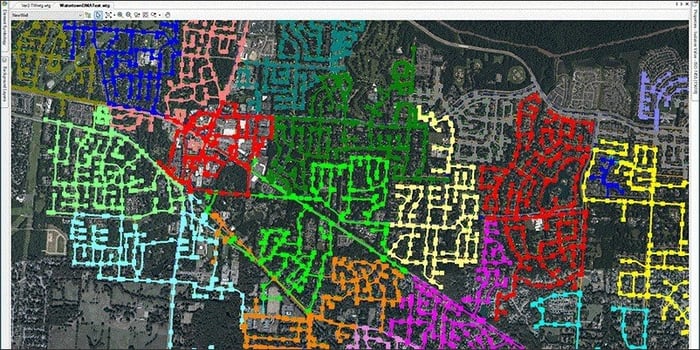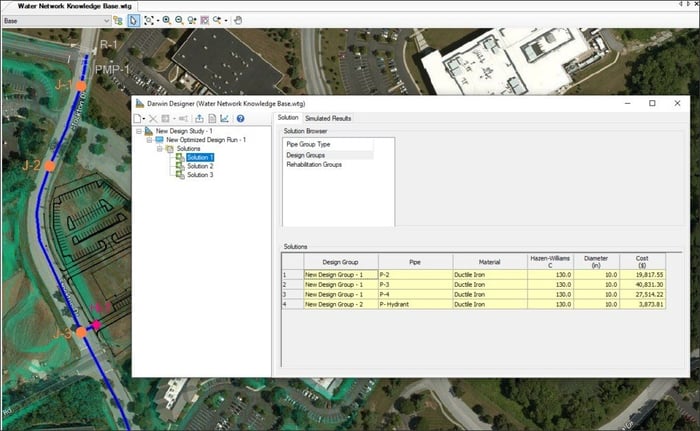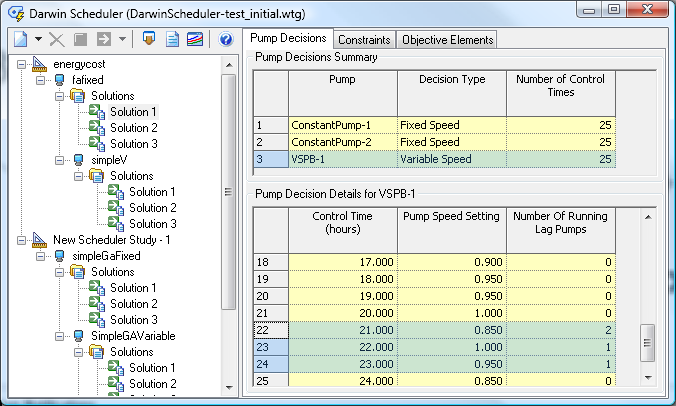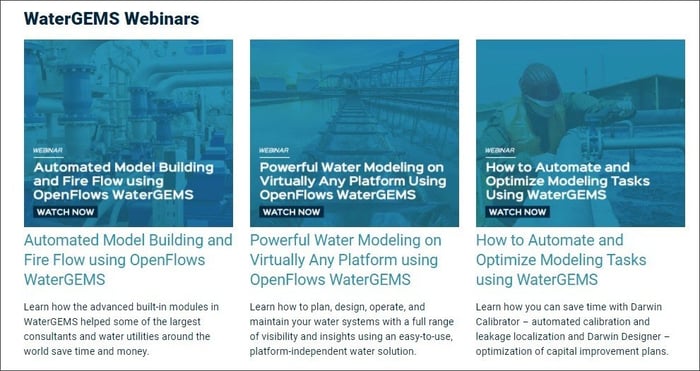Virtuosity Blog
How Growing Utilities Can Manage Their Water Distribution Systems Efficiently
Water utilities constantly make decisions and take action in an attempt to meet high standards of service with minimal costs and disruption. It’s a difficult, ongoing balancing act. As long as there is a population to serve, water systems must be effective and efficient.
Naturally, everyone wants to be smart about the choices and trade-offs they make. Infrastructure decisions have an impact that affects utilities’ customers and their systems, both currently and for decades to come.
Large or established water utilities often have engineering staff devoted to hydraulic analysis, or they hire consultants with extensive expertise in modeling. Growing utilities typically do not have these luxuries. If they have an engineer on staff who can perform hydraulic analysis, they often spend most of their time with several day-to-day responsibilities maintaining and repairing the network leaving very little time for operational planning and optimization.
To do that one must build, update, and maintain a hydraulic model – which will consume a lot of time, when using inferior software with unintuitive GUI and lacking features and technical support.
Similarly, consultants working with these utilities must also be extremely cost-efficient. They often need to deliver projects within tight deadlines. The faster they learn using the tool, the faster they deliver the projects, and eventually, they can spend more time prospecting or working on newer projects.
This is where a small investment in highly efficient software like Bentley Systems’ OpenFlows WaterGEMS can deliver a very quick return on investment. Read further to learn how.
Did you read our new eBook: Unlock Hidden Savings – A Guide for Growing Water Utilities
Primary Challenges Faced by Growing Water Utilities
Below are the primary challenges growing water utilities face when it comes to building and maintaining water network systems for their customers.
- Limited budget – As the growing utilities are still working to gain scale to provide quality services, often they adopt a leaner operation approach, which more often than not, means cutting down the operational costs to get more margin. As a result, utilities need to make clever investments that will allow quick, and sound returns to reinvest.
- Limited time – A leaner operation also means that utilities won´t have an unlimited workforce. This limited human resources scenario implies that even the most efficient staff, will likely be multi-tasking, focusing on the most critical activities.
- Risk aversion – If you add up the limited budget and budget with the high-quality services standards that utilities must provide their users, there is little room left for mistakes or taking unnecessary risks. Utilities just can afford to take big or major risks so they have to take a calculated approach -- tried and tested workflows may help them like OpenFlows WaterGEMS, a solution that is the result of decades of continuous development and is used and approved by numerous utilities worldwide!
- Get more with less – Deliver better output in the least budget. With only one solution (OpenFlows WaterGEMS) utilities can analyze, design, plan and optimize water networks. That means that you can trust only one solution for the conception and design to the operation and maintenance infrastructure lifecycle. It will also save time for the staff as it makes everything easier and simpler, and they do not have to spend extra hours learning a lot of other tools.
- Operation and maintenance – Projecting resilient and clever water systems, will result in more efficient systems, and being able to have a calibrated hydraulic model will also save energy costs and reduce NRW volumes. With OpenFlows WaterGEMS, operators will spot the leakage in a timely manner enabling them to plan ahead of the maintenance actions. They will actually know which District Metered Areas are more prone to water leakage and be able to address the problems accordingly. Hence, save energy, manage pressure and increase the lifecycle of your assets (tubes and pumps).
What is OpenFlows WaterGEMS

OpenFlows WaterGEMS is a stand-alone hydraulic modeling application for water distribution systems with advanced interoperability, geospatial model building, optimization, and asset management capabilities.
From fire flow and water quality analyses to energy consumption and capital cost management, OpenFlows WaterGEMS provides an easy-to-use environment for engineers to analyze, design, and optimize water distribution systems. It allows you to reduce non-revenue water significantly.
Hydraulic modeling can be used as a reliable decision-support tool, across a wide range of projects, from the design of a new system and pipe replacement to operation and emergency response.
Integration of your hydraulic modeling software with the leading GIS and CAD platforms will enable your staff to work in an already familiar environment and expedite both learning the software and generating useful results.
Save Time by Automating Hydraulic Modeling
Are you spending time on water distribution network modeling tasks that you wish could be automated or simplified?
With technology innovations, engineers can save hundreds of hours of time on repetitive modeling tasks and avoid inefficiencies.

Among the optimization features, OpenFlows WaterGEMS comprises a module called ‘Darwin Designer’. This module allows users to easily evaluate and identify the most optimal design and rehabilitation strategies based on three objectives: minimization of costs, maximization of benefits, or multi-objectives.
Additionally, you can enter restrictions, allowed pipe sizes, and associated unit costs to execute manual or automatic designs. The underlying technology uses a genetic algorithm for optimization.
Learn more about Darwin Designer
Cut Down Your Energy Bill by Optimizing Pump Operation
Darwin Scheduler in OpenFlows WaterGEMS allows you to optimize pump operations. By using genetic algorithm optimization to control nominated pumps during an extended period simulation (EPS), it avoids a manual trial and error approach to finding the most efficient operating schedule. Solutions and costs calculated using Darwin Scheduler can be exported back to the selected scenario.
Previously, the only way to optimize pump operations in a model was to use trial and error, changing settings in the model manually and then computing the model. Darwin Scheduler allows for optimized solutions to be calculated with a genetic algorithm similar to that found in Darwin Calibrator.

This tool allows for a more efficient analysis of a model. The optimization only knows the best solution relative to other solutions already found during computation. The power of this is in that the study runs through a large number of possible solutions and can often find a very good solution to fit the model.
Darwin Scheduler is used in EPS models only. It is recommended that the model is well-calibrated so that you get the best results.
Learn more about Darwin Scheduler
Hydraulic Analysis and Operations Made Easier
Here are some of the analysis features that are being used by growing utilities to save time and money:
- Scenario management – Quality software can efficiently evaluate several designs and compare the results or analyze the operation of an existing system under numerous extreme and typical conditions. In OpenFlows WaterGEMS, scenarios and alternatives are based on a parent/child relationship, making the analysis process efficient and flexible such that changes created in a dynamic design process do not have to be made and validated in several locations, but rather cascade through the hierarchy of the project.
- Easy model building –Jumpstart the model-building process and manage your model effectively so that you can focus on making the best engineering decisions. Leverage and import many well known external data formats, which maximizes the return on investment for geospatial and engineering data and automates input data generation. OpenFlows WaterGEMS includes the ability to leverage numerous electronic data sources, as well as flexible operation within CAD and GIS platforms to allow access to and comparison with record drawings and live GIS asset and background data.
- Criticality analysis – OpenFlows WaterGEMS enables you to include all valves in a hydraulic model without increasing the number of pipe elements and degrading performance. Find the weak areas or links in water distribution systems and assess the adequacy of isolation valves. Evaluate the ability to isolate portions of the system, generate network segments and serve customers using different valve locations.
- Fire flow analysis – Access and identify inadequacy in fire protection and design improvements to meet fire-flow and protection requirements. Design improvements such as the sizing and location of pipes, pumps, and tanks in order to meet fire-flow and protection requirements. OpenFlows WaterGEMS includes automated fire flow analysis tools so that you do not have to manually create scenarios and iterations to evaluate every hydrant location.
- Assess water quality – Carry out water quality analysis easily using simulations to help solve water quality problems. You can create water quality simulations for chlorine decay, water age, source tracing and multispecies analysis (MSX), etc. OpenFlows WaterGEMS enables a comprehensive thematic display of results, both within and apart from GIS platforms, to get a clear understanding of how and where problem areas develop in your system.
- Flushing analysis – Optimize flushing programs with multiple conventional and unidirectional flushing events in a single run. Increase velocity in mains to flush out solids and stale water, with the primary indicator of the success of flushing being the maximum velocity achieved in any pipe during the flushing operation. OpenFlows WaterGEMS includes automated tools for flushing analysis, including the ability to print a sequenced report for use in the field.
- Great visualization – You can use tools such as color-coding, annotation, profiling, and graphing to create a better visualization experience in your modeling application. This helps to create and present information in an interesting way. Easily implement background images such as Bing Maps.
What’s Next?
Water utilities that have invested in OpenFlows WaterGEMS are realizing great success with their water projects. Read their success stories.
If you are interested to learn more about OpenFlows WaterGEMS – here are three handpicked webinar videos for you and a comprehensive product demo video that will show you how easy it is to get started and work on OpenFlows WaterGEMS. Watch them here.




